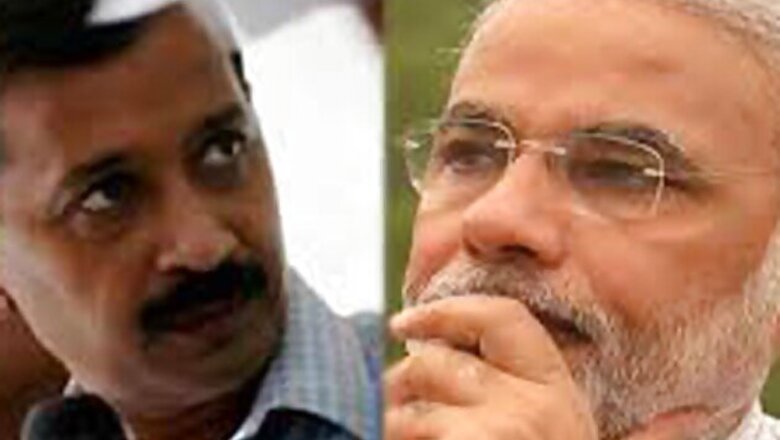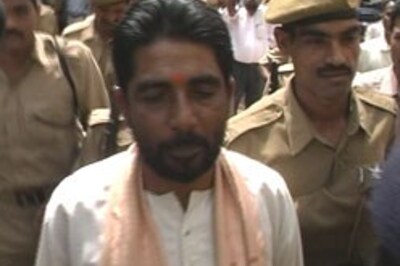
views
Thirty two years and thousands of crores of rupees later, the fight to clean Ganga is now pinning hopes on a high-profile Lok Sabha battle in Banaras, where this sacred river becomes million-times more polluted than the level fit for bathing.
Hopeful of their cause finally moving from ghats of Benaras to the Parliament, proponents of 'Save Ganga Campaign' have secured commitments from BJP's prime ministerial candidate Narendra Modi, Aam Aadmi Party's Arvind Kejriwal and others in poll fray from this holy city.
The campaign was launched by non-government organisation Sankat Mochan Foundation's founder president late Veer Bhadra Mishra in 1982, while his son Vishwambhar Nath Mishra is spearheading the cause since death of his father last year
The foundation, whose mission is to ensure "not a drop of sewage water in Ganga", had managed to secure way back in 1986 the support from the government with the launch of a 'Ganga Action Plan'. The plan, however, could not succeed as it was mired in corruption and poor strategy, while its second phase also failed to make much headway.
Vishwambhar Mishra, who is now mahant (head priest) of the famous Sankat Mochan Temple like his father and belongs to one of the most respected families in the city, said that no plan can succeed unless it is ensured that all kinds of sewage discharge into the river is stopped totally.
"We have talked to Modi about our campaign and he has assured us that necessary steps would be taken to ensure success of our campaign," Mishra told PTI in an interview.
He has also secured similar assurances from Aam Aadmi Party's Arvind Kejriwal, who is fighting against Modi in Varanasi. "Besides, Congress, which has fielded Ajay Rai in Lok Sabha polls, has also committed his support," he said.
The gravity of situation can be gauged from the fact that Ganga water in Benaras is million-times more polluted than the level fit for bathing, Mishra said. Ironically, the Ganga enters Benaras fully clean, but gets polluted by the sewage discharged through drains and sewers from the city, he laments.
Various government programmes have already seen thousands of crores being spent without much success. "The thing is you do not even need to spend any huge money to work on Ganga and all you need is to change your system.
"There is no point in wasting money if there is no fool-proof plan. There is no point in even taking money from World Bank or other organisations if you are not able to implement the project in an effective manner," Mishra said.
"The good thing is there seems to be political will now and this needs to be taken up a a dedicated project. The need of the hour is to ensure that city's sewage does not get into Ganga and if you need to change the city's sewage system for that we would have to do it.
"Varansi's sewage system is being changed at the pretext of Ganga, but the grass-root reality is that what needs to be done is not being done. There is also no transparency about the work being done currently," Mishra said.
Mishra, whose father was a professor of Hydraulic engineering and former Head of Civil Engineering Department at the Banaras Hindu University here, is hopeful that the work started by his father and the Sankat Mochan Foundation would finally yield desired result, given the importance this Lok Sabha election has got due to Modi's candidature from here.
"Good thing is that all parties are promising to work on this issue for the first time. For the first time, a political motivation seems to be there, although we have been trying for a long time. Now, even if people try to side-step this issue, we would certainly catch them and seek explanation," he said.
Mishra met Modi when the Gujarat Chief Minister came to Varanasi, while Kejriwal stayed for a few days at a Tulsi Ghat guesthouse of the foundation earlier this month.
The guesthouse is a few kilometres away from the Sankat Mochan Mandir, which was founded by famous poet-saint Tulsidas. Mishra said that the place is open for everyone and even Modi can stay if he wishes so.
Mishra said that Kejriwal has talked to him about the need to push for Ganga project and he has promised to work on this if he gets elected from here.
"Modi has also promised to do so and I will remind him about this issue everytime I will meet him. Congress has also committed to this cause and the project had got support from late Rajiv Gandhi at one point of time," he added.
"We would talk to leader whoever emerges winner from here and would remind him about his commitment. We hope that the issue would move ahead in a right direction now," Mishra said.
The Mahantji, as he is commonly known as, said that the issue has been made complicated over the years.
"Some work is done in the city and people are told that the work is happening for Ganga. However, the reality remains that 22 sewers and drains used to merge into Ganga about 15-20 years ago, it rose to 27 and today there are 35. This continuous increase is a dangerous trend.
"As such the population density is high here and the sewage system is over 100 years old. New pipes are being put for sewage and excuses are made about treatment plant.
"A huge amount of public money worth about Rs 150-200 crore has been put into such work (sewage) without any result. This is wastage of money," he said.
"Today, there is no planning with regard to discharge of sewage into the river, treatment and other issues. The discharge is growing every day.
"The technology being used today is completely obsolete. The situation here is that whenever we dispose off the sewage it will either go to Varuna, or Assi, or directly into Ganga.
"Even if it goes into Varuna or Assi, it would eventually go into Ganga. So, the whole issue is about Ganga and once the sewage gets into Ganga, there is no technology available in the world today that can separate it out," he said.
The city of Varanasi derives its name from Varuna and Assi -- two small rivers on its boundaries, which merge into Ganga, which forms the third boundary of this holy place, which is also used for performing last rights for religious reasons.
"Even dead bodies that get into Ganga float above the water. That may be an eyesore and a disturbing sight, but even that is not as harmful as the sewage.
"Dead bodies can be taken out of water immediately to contain the harm, but once the sewage gets into Ganga, the bacteria would live for its life as it gets nutrition in the water and it would also survive within the body of whoever drinks this water," Mishra said.
The Mahant said that the water is clean at the point where Ganga enters the city area.
"But the moment Assi meets into Ganga, the things start getting bad and that is the contribution of Benaras to Ganga. The sewage discharge into Ganga starts at Assi ghat and the things start further worsening as you move ahead," he said.
According to Central Pollution Control Board standards, the coliform level should be below 500 per 100 ml for the water to be fit for bathing, while Ganga water is also used for drinking and sipping due to religious reasons.
"The count at Assi itself is 45,000-50,000. Once you reach towards the end of the city at Varuna, the level reaches into millions and the Ganga water actually becomes septic in these areas. This is the gravity of situation," he said.
"The irony is if you further move 15-20 km down the Ganga after Banaras, the river water again recovers its health and the water becomes clean naturally as there are no sewage discharges in those areas.
"The thing is that the water that is being used is sourced from the river between Assi and Varuna. The pumphouse where water is pumped out for drinking purposes after chlorination, that is a few ghats after Assi," he said.
Mishra also said that the new concepts where people talk about more water being released to lower the river pollution level were of no use as "that would only lower the concentration of severage, not cure it".
"The single solution should be about stopping discharge of severage into Ganga. The way Ganga enters Banaras, it should leave the city also like that. If you want to take something from Ganga, please take it, either for prayers or for drinking, but don't give anything to it. The problem is we are giving bad things to Ganga.
"Right now what is happening is that we are also taking water from Ganga and then convert the same into sewage and give it back. We take clean water from Ganga, but are giving sewage to it. Ganga should not be used for sewage disposal and whatever technique is required for that, we need to explore.
"A good proposal was given to lay down an interceptor along the bank to collect all the discharges from the city and that can be flown down by virtue of gravity to outside the city down the stream and there can be a treatment plant.
"Even a place was identified for such a plant. That was a good proposal, but somehow could not get implemented. There is even scope for increasing the capacity as per the needs."




















Comments
0 comment